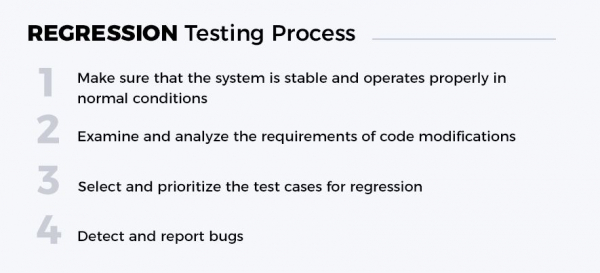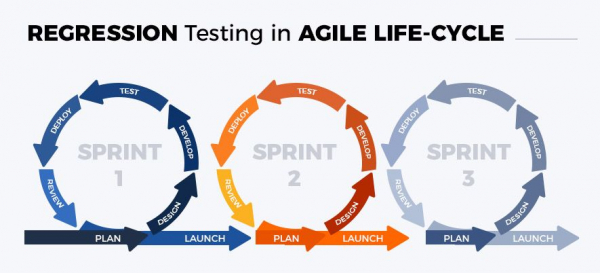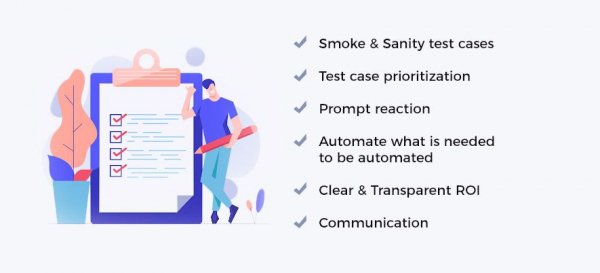What is regression testing? What is Agile? What are the problems of regression and how they can be solved with Agile? Most importantly, what are the best practices to implement regression testing in agile? Whether you are an absolute beginner, or experienced specialists searching the answers to these questions, this guide will help you to get ducks in a row and comprehend the full picture of regression in agile in software testing.
What is Regression testing?
Software development is a fluctuating process that often requires applying new adjustments. In case when found bugs were fixed, or any other features were included, a standard way of testing will not be enough. But it is the right time when regression testing comes to play.
Regression testing means rechecking and re-testing the software that was changed. The primary goal is to ensure everything is satisfactory after changes, and there are no side-effects or unacceptable behavior.

Regression testing refers to a black–box technique and is comprised of three types: Unit regression, Partial regression, and Complete regression. The regression testing process includes four stages: checking system in normal conditions, analysis of the requirements of code modifications, selecting test cases for regression and bug detection, and reporting.
Regression testing problem
Through regression testing, it is often complex to predict how much time it will take, and what are the further steps of testing. It is impossible to know what types of bugs will be found. For this reason, the most daunting challenge with regression testing is time. To adequately handle staying within schedule and project budget is the first and foremost task for QA engineers. To make the regression testing procedure as efficient as possible, you can conduct it in Agile.
Regression testing in Agile: How it works?
Agile is a flexible approach to tasks management and organization. It is used both in software development and testing and takes into account all the requirements and new adjustments throughout the process. Regression testing in Agile is about dividing big complex tasks into more minor parts. The dominant feature of this approach is communication, constructive discussion on each step made by each team member.

Agile Testing Life-cycle can be divided into several sprints - defined time intervals for which a specific scope of tasks should be done. An essential condition for each step is to analyze all the work done and reestimating what needed to be done on the next step. Each task in Agile is performed following existing requirements and criteria that appear at a particular phase of work.
Regression testing in Agile is comprised of five parts:
- Preparation. It involves creating Agile Test Plans, giving the first estimation of everything needed to be done.
- Daily Scrums-meeting. Communication and re-estimating all the tasks due to possible problems and changes.
- Review. Analysis of the progress of the software testing process.
- Release Readiness. QA team decides which features are ready to go live and which are not.
- Impact Assessment. Feedback phase of the life cycle which helps testers set goals for the next life-cycle.
As practice shows, the Agile approach for testing takes much time on planning, but in the end, it prevents facing more significant problems like fixing and re-working on previous tasks.
Best Practices for Regression Testing in Agile
During regression testing, it is mandatory to adhere to the following points:

- Smoke & Sanity test cases. These tests done prior to regression helps to check functionality and so better estimate what error-prone areas are needed to be checked by regression.
- Test case prioritization. For successful regression testing in agile, it is crucial to accurately assess all the risks and more priority tasks. On each step of sprint-planning, the QA team should select urgent tasks and focus solely on them.
- Prompt reaction. Regressions undoubtedly require constant and rapid analysis of bugs reports at each step of the task. It is better not to procrastinate in providing feedback, as the team can already go further and perform utterly different test cases.
- Automate what is needed to be automated. Another method of regression testing in agile is to assess what should be automated and what should not. Frequently by resorting to the automation of the wrong elements, you risk typically spending a whole cycle of tasks in vain. If the test cannot be automated, this process must be stopped immediately.
- Clear & Transparent ROI. When conducting regression testing, it is crucial to keep in mind the ROI for both the team leader and each tester in particular. Focus on providing clear ROI and regression testing reports with which you can accurately track noticeable results.
- Communication. Last but not least is the ability to communicate. QA engineers should possess a vivid understanding of how it is better to clarify the problem and make it clear both for product owners and developers. Apart from this, it is important to support effective communication within a QA team.
Consequently, all this contributes to a stable and sustainable result.
What is the end value of Regression testing in Agile?
All-in-all, the Agile approach offers a host of technical and business benefits to regression testing. With the Agile development approach, QA teams can attain accelerated time-to-market, ROI, and, most importantly, product enhancements. A review of the work step by step helps to avoid all possible rework in the future.
If your products are requiring testing, we are ready to hedge your team and ensure the high quality. We are participating in the life of the product, and do our work with a passion for your success. Let's make great products together.
Visit our blog to read more about QA & testing. Feel free to contact us for collaboration.
